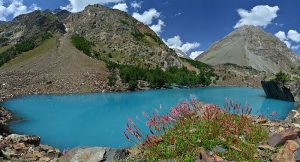For the last three years, the arrival of summer has been a nightmare for those who live in the mountainous northern areas of Pakistan. Summer means a sudden increase in temperature that often eventually ends in a glacial lake outburst flood (GLOF).
The same phenomenon was in late May, when yet another outburst flood happened at Shisper Glacial Lake in Hassanabad, Hunza valley of northern Pakistan.
Due to sufficient preventive measures taken by the local government, the flood did not cause as much harm as such incidents had in 2019. That year, flooding from the glacial lake submerged large section of the Karakoram Highway, a bridge, two power stations, some offices, over 100 houses, the water supply pump station, and a number of farms. The recent incident was less severe, but still enough to create havoc for the downstream localities in the area. The Karakoram Highway, the only road that connects China and Pakistan, remained closed due to the Shisper Glacial Lake outburst, underlining the potential implications of the GLOF phenomena on the China Pakistan Economic Corridor (CPEC).
The 12 km Shisper Glacier turned into a lake in early 2000. Since then, outbursts take place time and again, impacting the lives of people residing the area. Even preventative safety measures take a toll.
Dilshad Bano, 48, lives in a shelter with her husband and a 10-year-old daughter because her house was demolished by the authorities to implement safety measures to minimize the impact of GLOFs. Until now, more than 35 houses have been marked as falling in a danger zone that might be affected by GLOFs in the future.
“The only agricultural land which I had inherited from my father has vanished due to the outburst and now it’s a ravine,” Sher Ali, a 53-year-old resident of Hunza, said. Ali also lost his apricot farm, which was the major source of his income, in a GLOF.
Glacial lake outburst flooding is not new in Pakistan. For the last two decades, the northern parts of the country have witnessed such glacier outbursts often. Furthermore, the number outburst incidents is increasing with the passage of time, yet another example of the toll climate change is exacting on the country.
In 2020, in a remote village of Chitral, a teenage girl was killed and 11 people injured when a glacial flood swept away six houses, damaging 16 others. The glacial flood also destroyed the standing wheat and bean crops, costing huge revenue losses for the local residents.
Pakistan hosts more than 7,000 glaciers, out of which 3,044 have formed glacial lakes. Many other have been marked as a potential risk due to rising temperatures. The potential glacial lakes threaten the lives of at least 7 million people in both Gilgit Baltistan and Khyber Pakhtunkhwa.
Experts believe that the sudden increase in GLOFs on a regular basis is due to climate change and the situation will worsen if strong and practical measures are not taken to prevent the phenomenon. Although Pakistan contributes less than 1 percent to global emissions, the country is ranked seventh-most vulnerable country for climate catastrophes.
Bilal Khan, an environmentalist, believes that at the very least the government should relocate the inhabitants of the area and create feasible engineering structures including delay action dams, ponds, gabion walls, and reforesting to mitigate the toll of such GLOF catastrophes.
The melting of the glaciers at this pace is also concerning because annual glacier melts are a major source of water for irrigation and other uses in Pakistan. A huge proportion of clean water is now being lost to the sea for the lack of proper mechanisms to utilize freshwater resources.
The country suffers from water scarcity, and if the current pace of glacier melting continues, apart from infrastructure and economic losses, Pakistan will lose a major portion of its water supply.
In the view of Zahra Khan Durani, a climate change expert, deforestation is the primary reason behind the warming of Pakistan’s northern areas, resulting in soil erosion, mud flooding, and glacial lake outburst flooding. The more than 2 million people in the northern parts of the country chop down trees to use their wood for cooking and heating. Hence, deforestation is on rise.
Durani stresses the government must follow a multipronged strategy to ensure environmental sustainability. To her, mass plantings of trees is not the only solution to deal with deforestation. Rather, it is one step out of many that Pakistan can use fight climate change. In addition, Durani urged the government to ensure that cleaner resources are utilized to meet current and future energy needs, whether it is through the provision of liquefied natural gas (LNG) or the installation of solar projects. One thing is certain: The country cannot afford to neglect environmental degradation anymore.

































